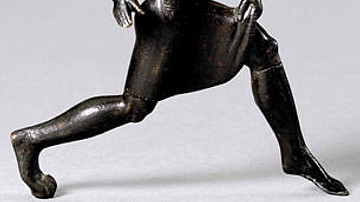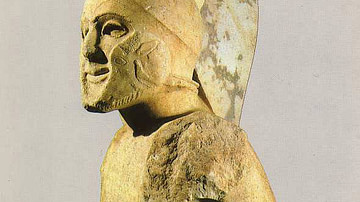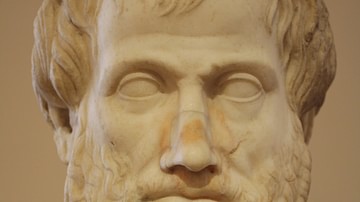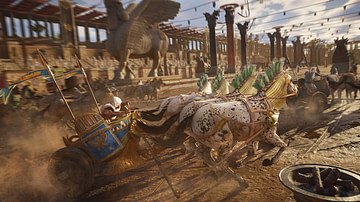Spartan women had more rights and enjoyed greater autonomy than women in any other Greek city-state of the Classical Period (5th-4th centuries BCE). Women could inherit property, own land, make business transactions, and were better educated than women in ancient Greece in general. Unlike Athens, where women were considered second-class citizens, Spartan women were said to rule their men.
The Greek philosopher Aristotle (l. 384-322 BCE), who spent most of his adult life in Athens, criticized the independence and influence of Spartan women in his Politics, claiming that women’s autonomy in Sparta was responsible for its decline because nature had intended for men to rule over women while, in Sparta, the reverse policy was practiced (1269b.12). There is no evidence to support Aristotle’s claim but a significant amount showing how the equality of the sexes in Sparta actually made the city-state stronger and more efficiently run than others.
The laws of Sparta were reformed by the king Lycurgus (l. c. 9th century BCE) and emphasized the importance of equality among all citizens. Girls were given the same physical fitness regimen as boys (though they were not trained in arms or Greek warfare) and were educated at the same level at home (while boys would attend a public school). The subjugated class of people known as helots took care of menial labor, including weaving of clothes, allowing a female Spartan to concentrate on what Lycurgus believed their most important role: motherhood. Spartan women were famously proud of their children who were expected to honor the city-state through virtuous behavior. At the same time, women had the responsibility of running the farm or estate, managing finances, and operating businesses as the men were frequently away at war.
The purpose of sex within marriage was to create strong, healthy children, but women were allowed to take male lovers to accomplish this same end. Same-sex relationships among men and women were for pleasure and personal fulfilment. These relationships were regarded as natural as long as both parties were of a certain age and had consented. Although Athens is frequently referenced as the “birthplace of democracy”, Athenian women had no voice in politics or their husband’s business whereas Spartan women participated freely in almost every aspect of their city-state’s political and social life.
Status of Women in Athens vs. Sparta
Women in Athens were relegated to the background except for their participation in certain religious festivals and rituals. An Athenian girl was raised to learn how to weave from her mother and care for children and the home. One of the most telling details regarding the status of females in Athens and Sparta is noted by scholar Paul Cartledge:
Heiresses in Sparta – that is, daughters without legitimate brothers of the same father – were called patrouchoi, which means literally 'holders of the patrimony', whereas in Athens they were called epikleroi, which means 'on (i.e. going with) the kleros (allotment, lot, portion)'. Athenian epikleroi, that is, served merely as a vehicle for transmitting the paternal inheritance to the next male heir and owner, that is to their oldest son, their father’s grandson, whereas Spartan patrouchoi inherited in their own right. (169)
Through liaisons with men other than their husbands, Spartan women could also acquire control of more than one home and surrounding lands, and many became wealthy landowners. There were a significant number of widows in Sparta who had lost husbands and sons in the wars but never had to worry about survival because they owned the land and knew how to make it profitable.
Although some Athenian women are mentioned as merchants, potters, or pursuing other careers, they were routinely secluded from men (possibly even in the home) and had no legal recourse in the courts, limited economic power, and no political voice. A female Spartan had all of these rights and were brought up from childhood with the understanding they had as much to contribute to the state as men.
Girls’ Childhood & Education
The reforms of Lycurgus covered every area of Spartan life from currency to land ownership and warfare as well as spheres which might be considered a citizen’s private affairs such as dining, marriage, and childrearing. Spartan men and women were expected to eat together in dining halls, the men separated from the women, and children of both sexes were to be brought up physically fit and educated.
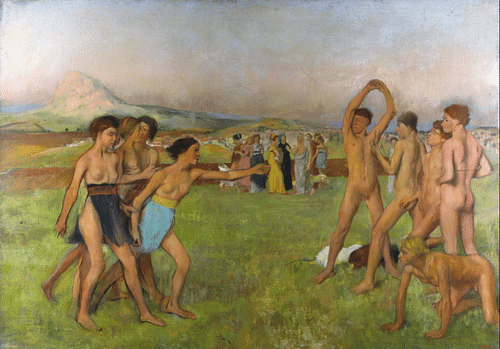
Boys were raised by their fathers until the age of seven when they were taken to live communally with others and begin life in the agoge, the Spartan education program mandated for all males, which emphasized military training. Spartan girls remained under the tutelage of their mothers but were expected to participate in the same physical fitness routines as the boys, in which all participants were naked, as well as attend festivals and religious rituals where males and females contributed to the event.
Sports a female Spartan participated in could include wrestling, long- and short-distance running, horseback riding, hurling the javelin or discus, boxing, and racing. Education for girls also included singing, playing a musical instrument, dance, and the composition of poetry all of which came under the umbrella term mousike (“music”) which was thought to enrich and ennoble one’s character. Lyric poetry in the style of Sappho of Lesbos (l. c. 620-570 BCE) and the poet Alcman (l. c. 600 BCE) was the genre taught to the girls and the style Greek women mainly (or perhaps only) composed in. Scholar Jane McIntosh Snyder comments:
All [Greek female poets] wrote primarily in the same genre already established as appropriate for women by the reputation of their predecessor, Sapho, namely lyric poetry…But whereas Sappho’s poetry appears to have been intended primarily for solo performances (that is, one singer accompanied by a lyre), some of these new writers ventured – to judge from the meters they used – into lyrics meant for choral performance by a group of singers, often perhaps in connection with a local religious festival tied to the agricultural calendar or as part of some other town ceremony. (40)
This same paradigm applied to Sparta where all-girl choruses were formed and competed for prizes. Sometimes these competitions were part of religious festivals but also seem to have been included in events honoring an individual, such as singing the praises of a given politician or, conversely, making fun of someone, as in mocking men of a certain age who had not yet married, there by encouraging adherence to social traditions. Choruses also performed at the dedication of temples or the planting of crops.
These choruses gave rise to the genre of Greek poetry known as the partheneion (“maiden song”) conceived of by the lyric poet Alcman who either was Spartan or lived most of his life in Sparta. The “maiden” referenced was the goddess Ortheia, another name for Artemis, but also referred to the singers themselves and the objects of their affection, other girls. Extant fragments of maiden songs make clear that some of these were composed by women in praise of other women suggesting a romantic and erotic relationship.
Sexuality, Marriage, & Motherhood
Same-sex relationships in Sparta were as common as they were elsewhere in ancient Greece as there was no such distinction as homosexual and heterosexual, these being modern-day constructs. In his Life of Lycurgus, which includes a discussion of Spartan sexual mores, Plutarch writes:
The boys’ lovers also shared with them in their honor or disgrace; and it is said that one of them was once fined by the magistrates because his favorite boy had let an ungenerous cry escape him while he was fighting. Moreover, this sort of love was so approved by them [the Spartans] that even the maidens found lovers in good and noble women, still, there was no jealous rivalry in it, but those who fixed their attentions on the same person made this rather a foundation for friendship with one another, and persevered in common efforts to make their loved one as noble as possible. (18.4)
Same-sex relationships, whether between males or females, were considered natural both before and after one was married. Unlike girls in other city-states who might marry as young as 13 or 14, a Spartan woman usually continued her education until 18 or 20 and only then considered proposals by suitors brokered by her father or older brother. Scholar Colin Spencer notes, "Love between two adult men occurred often, but only the 'effeminate' man incurred the social opprobrium" as evidenced by derogatory terms used for a man who "played the part of a woman" in sex but none for the relationship itself (51). No such terms seem to have been applied to female same-sex relationships which, as noted, might continue after the woman had married.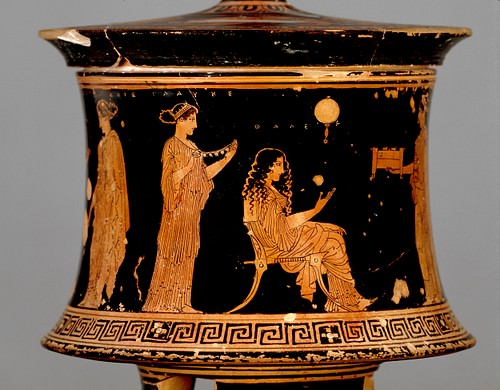
The marriage ritual in Sparta began with a symbolic kidnapping in which, after the families had agreed to the union, the female Spartan was forcefully taken by the man to their new home and left with female attendants who prepared her for the marriage night. Her head was shaved, and she was given a boy’s clothes and left in a darkened room. At some point in the night, her new husband would surprise her, the couple would have sex, and then the man would leave to return to the barracks where he lived.
Cartledge notes how "it was said that a Spartan husband might father several children before he saw his wife in daylight" (172). The wife was then expected to keep her hair closely cropped throughout the marriage. Some scholars have suggested this ritual was enacted to make the man, who had known only the company of other males up to this point, more comfortable in having sexual relations with a woman. The wife’s closely cropped hair, in the same style as a Spartan male’s, is also thought to relate to this same situation, make the woman appear boyish or manly.
Once married, Spartan women were expected to produce children. Cartledge writes:
Wifehood and motherhood were every Greek female’s social as well as anatomical destiny – and nowhere was that emphasized more than in Sparta. The divine recipient of worship in connection with pregnancy and childbirth was Eileithyia, closely associated in Sparta as elsewhere with Artemis (Orthia). (175)
Artemis was also associated with same-sex female relationships as she was frequently depicted surrounded by young women as her devotees. The maiden songs in praise of Artemis, in part, celebrated the transition of maiden to bride to wife and mother. Motherhood was highly regarded, and Spartan women are said to have been especially proud of how their independent status allowed them to raise equally strong and independent children.
Plutarch relates the story (possibly apocryphal) of Gorgo of Sparta, wife of King Leonidas who, "being asked by a woman from Attica, 'Why is it that you Spartan women are the only women that lord it over your men' replied, 'Because we are the only women that give birth to [real] men'" (Moralia 218D.4). By this, she meant that real men were not afraid of strong women, implying the obvious lack of same in the men of other city-states. Although the woman’s sons had been raised apart from her, they were still expected to honor her and, in fighting for the state, were also fighting for their mothers and home.
There are many anecdotes related by Plutarch regarding women’s pride in their sons’ military victories and their shame at cowardly behavior. One example of this is Damatria, a woman honored with an epigram for killing her son who had proved himself a coward in battle. The most famous, though, is the story of the mother handing her son his shield as he was going off to war, telling him to return either with the shield or on it, referencing the practice of returning a dead soldier on his shield.
Women’s Responsibilities, Rights, & Attire
Women’s rights were directly linked to their responsibilities. Since the men were away so often at war, a female Spartan had to run a home, farm, or estate by themselves. Their chief duty was to give birth to sons who would bring honor to the family and the state through bravery in combat and women were expected to maintain their health and physical fitness primarily for this purpose. Daily chores which were considered "women’s work" – especially weaving, house cleaning, and childrearing – were done by helot women. The helots were a class of people subjugated by the Spartans who were not slaves but not regarded as equals. Some scholars have claimed that Spartan mothers did not even breastfeed their children as they had helot wet nurses for that.
Spartan women concentrated on finance, agriculture, and the efficient operation of the home. The female head of the house had the last word in whatever decisions were to be made and kept the farm and home running smoothly. They were also expected to participate in religious rituals honoring the gods of the state so that these gods would reciprocate with the gifts of military victories and bountiful harvests. There were also a number of cults women dedicated themselves to regarding fertility (such as the Cult of Artemis-Eileithyia-Orthia) or feminine strength as in the case of the Cult of Cynisca, the first woman to have won the Olympic games by training her own horses.
Spartan women’s attire reflected the value of austerity that characterized the culture. They usually wore a peplos, a body-length dress, belted at the waist and drawn up to their knees or higher. Unmarried women wore their hair long and married women, as noted, closely cropped and sometimes covered by a veil that fell over their faces. Although Lycurgus had outlawed silver and gold because it led to avarice and crime (replacing gold and silver currency with iron), this law was later amended for the production of jewelry, and women wore gold and silver bracelets and necklaces. They also used cosmetics – which Lycurgus had also outlawed as encouraging vanity – and wore perfume. Ostentation was frowned upon, however, as equality was a central cultural value and so Spartan women, more or less, looked alike in terms of wealth within their social class.
Conclusion
Contrary to Aristotle’s assertion, Spartan women had nothing to do with the decline of the city-state. Sparta was at its height, even after decades of warfare, when it challenged the strength of Thebes. At the Battle of Leuctra in 371 BCE, Sparta was defeated by the Theban army under the command of Epaminondas (l. c. 420-362 BCE), a force which included The Sacred Band of Thebes – a unit of 150 same-sex male couples – under the brilliant leader Pelopidas. Epaminondas and Pelopidas inflicted heavy casualties on the Spartans who lost 400 of their 700 hoplite foot soldiers and their king Cleombrotus in the battle.
Prior to Leuctra, Sparta had seemed invincible and so Greek writers, before and after Aristotle, had to find some reason for their defeat other than the obvious - that Epaminondas and Pelopidas had outmaneuvered and outfought Cleombrotus – because that was somehow just unacceptable. The reason these later writers came up with was the autonomy of the Spartan women, which had weakened the state to the point where it was bound to fall. Cartledge comments:
What Aristotle and other conventionally minded non-Spartan men feared subconsciously and perhaps sometimes consciously was feminine power. One expression of that Greek male fear was the invention of the mythical race of Amazons, but at least the Amazons had the decency to live apart from men, whereas the Spartan women apparently exercised their power from within the heart of the community. In the grip of such fear, the male sources often distorted the facts they had access to, usually only at second-hand at best, about Spartan women. (170)
In reality, Sparta was at its best when men and women were regarded as equals. The female Spartan was honored as the equal of the male in her own sphere of power and authority and, even in the accounts of detractors, performed admirably. It could be argued, in fact, that the strength of the Spartan women allowed for the formidable reputation of the same in the Spartan men.


